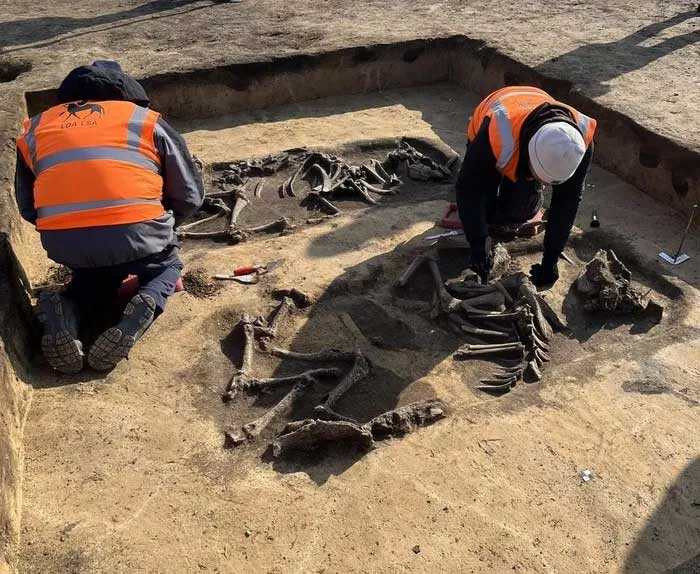A 6,000-year-old skeleton was revealed at the start of a chip factory
Intel's new multi-billion dollar semiconductor factory in Germany has helped archaeologists find two prehistoric graves from human sacrifices.
This location is located near Magdeburg, about 160 km west of Berlin, and is where Intel plans to build two semiconductor factories on land later this year, according to CBS News .

Excavations at this site are ongoing and are expected to end in April. (Photo: LDA).
The Saxony-Anhalt State Office for Heritage and Archeology Management (LDA) inspected the 300-hectare industrial park before the Intel factory project started construction. There, they discovered a small hill in an industrial area containing burial mounds dating back to the Neolithic period.
Below the hill are two "colossal mounds" that cover wooden tomb chambers with many tombs inside. These two tomb chambers are said to be about 6,000 years old and contain remnants of ancient rituals such as chariot tombs . This is where livestock were sacrificed and buried with human bodies, simulating the image of a cart with a driver in front or animals pulling a plow.
LDA calls these spectacular new discoveries, and shows important activities of prehistoric people, lasting a long time.
Archaeologists have found traces of one of the two tomb chambers. It belongs to the Baalberg people , a Stone Age culture that existed in central Germany from around 4100-3600 BC. There are two trapezoidal burial chambers built of wood hidden inside the mound. Along with that is a corridor running between the two tombs, possibly a place where ancient people moved and brought sacrifices.

A 5,000 year old grave of a man (front) and 2 cattle (back). (Photo: LDA).
Along the procession route, archaeologists have found the remains of pairs of young cattle that were sacrificed and buried. Archaeologists believe that this tomb was built for a 35-40 year old man. Meanwhile, the remaining skeletons show that the cattle were sacrificed when they were 2-3 years old.
Speaking in a press release, the Heritage Management Office explained that ceremonial graves like these 'show that livestock are the most important assets' . They were seen as a guarantee for one's livelihood and were offered to the gods.
During their inspection of the grounds, archaeologists also discovered a ditch along the procession route and many other burial mounds in the area dating back about 4,000 years.
"The consistency in ritual practices in the Eulenberg area is astonishing. Further analysis of this find promises to yield even more interesting insights ," the Heritage Office said.
- China: Micro launched the first chip factory
- Video: robot skeleton to help workers porter goods
- Intel inaugurated 65nm technology chip factory in Ireland
- The 1,300-year-old twisted skeleton made the archeology confused
- Smart microchips can start and operate automatically when the battery runs out
- Discovered a 3,500-year-old male and female skeleton in the fist position
- The first case of Down syndrome in human history
- Detecting intact 6,000-year-old skeleton under construction site
- Headless skeleton of 6 meter long sea monster
- Intel expanded its investment in Asia
- Rediscover the 6,500-year-old remains
- The 800-year-old skeleton contains 'ghost cells' of deadly bacteria
 Discovered an ancient centipede fossil 99 million years old
Discovered an ancient centipede fossil 99 million years old Discovered bat-like dinosaurs in China
Discovered bat-like dinosaurs in China Discovered a 200-year-old bronze cannon of the coast
Discovered a 200-year-old bronze cannon of the coast Discover 305 million-year-old spider fossils
Discover 305 million-year-old spider fossils 1,500-year-old treasure found: Symbol of authority!
1,500-year-old treasure found: Symbol of authority!  China: Tomb Buried 46 Naked Girls and the Shocking Story Behind It
China: Tomb Buried 46 Naked Girls and the Shocking Story Behind It  China excavated the tomb of the Liao dynasty dating back 1000 years
China excavated the tomb of the Liao dynasty dating back 1000 years  The grave of the Chinese granddaughter's granddaughter and the mysterious 4-letter 'open person will die' on the lid of the coffin
The grave of the Chinese granddaughter's granddaughter and the mysterious 4-letter 'open person will die' on the lid of the coffin  Discover dozens of 2,000-year-old mummies in Egypt
Discover dozens of 2,000-year-old mummies in Egypt  Discovered ancient fortress more than 2,000 years old of Egypt
Discovered ancient fortress more than 2,000 years old of Egypt 